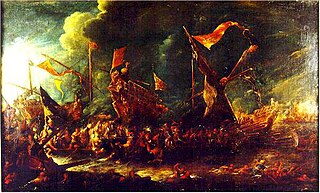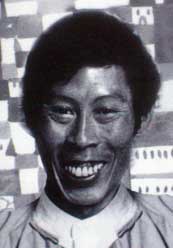Saya Chone | |
|---|---|
| Born | 1866 |
| Died | 1917 (aged 50–51) |
| Nationality | Burmese |
| Known for | Painting |
| Movement | Traditional Burmese painting |
Saya Chone (Burmese : ဆရာချုံ, 1866–1917) was a prominent Burmese painter based in Mandalay. He served as a royal court painter during the reign of King Thibaw Min, the last monarch of the Konbaung dynasty. After the British annexation of Upper Burma in 1886, he created many works depicting Burmese palace life.

Myanmar, officially the Republic of the Union of Myanmar and also rendered as Burma, is a country in northwest Southeast Asia. It is the largest country by area in Mainland Southeast Asia and has a population of about 55 million. It is bordered by India and Bangladesh to its northwest, China to its northeast, Laos and Thailand to its east and southeast, and the Andaman Sea and the Bay of Bengal to its south and southwest. The country's capital city is Naypyidaw, and its largest city is Yangon.

1613 (MDCXIII) was a common year starting on Tuesday of the Gregorian calendar and a common year starting on Friday of the Julian calendar, the 1613th year of the Common Era (CE) and Anno Domini (AD) designations, the 613th year of the 2nd millennium, the 13th year of the 17th century, and the 4th year of the 1610s decade. As of the start of 1613, the Gregorian calendar was 10 days ahead of the Julian calendar, which remained in localized use until 1923.
Monywa District is an administrative district in southern Sagaing Division, Burma (Myanmar). Its administrative center is the city of Monywa.

Ba Nyan was a Burmese painter who has been called the greatest name in modern painting in Myanmar. His oil paintings were quiet and academic in their style, but display occasional flashes of virtuosity and brilliance in bold, impasto brushstroke and skillful handling of the medium.
Burma Art Club or BAC was an art institution in Rangoon (Yangon), Burma which was established in 1913 or 1914 or even 1918 according to various sources. The club was located on the premises of the Rangoon Government High School. It afforded a twofold opportunity: first, it was a means to develop the British colonial painters' own talents and second, they were able to teach Western style painting to others in Burma.

Ngwe Gaing was a Burmese artist who worked in both oil and watercolor. After the death of his teacher Ba Nyan, he was recognized as the greatest living painter in Myanmar. He had great influence on the next generation of artists, and his works are now highly sought after.

Aung Khin was a Burmese painter who became prominent in the Mandalay art world. He is well known as one of the foremost and earliest of modernistic painters in Burma.
Khin Maung (Bank) (ခင်မောင် ; 1910 – 20 December 1983) was a Burmese painter and sponsor of the arts who was influential in the art world of Mandalay, Myanmar. More importantly, however, he was the major force for the development of a modernistic movement in painting in Burma, which began in the early 1960s.

Paw Oo Thet was a Burmese painter, prominent in the Mandalay art scene who became one of the initiators of a modernistic art movement in Burma in the early 1960s.
Ba Thet was a Burmese painter who worked in Mandalay, Myanmar and who was known as an advocate of experimentation in the arts. He was an associate of Kin Maung, who is known commonly known in Burma as Kin Maung (Bank) to differentiate him from another painter of some renown, Kin Maung (Yangon). Kin Maung (Bank) is generally regarded as the "Father of Modernist Painting" in Burma.
San Win was a painter who is renowned in Burma as the first Burmese painter to embrace impressionism as his chief style of depiction. He is also well known as a devoted and tireless government official who presided over art programs in Burma.

Bagyi Aung Soe was a Burmese painter renowned for his modernistic, semi-abstract art, which caused such a shock in Burma when it appeared that many called it "psychopathic art". The name "Bagyi" is his phonetic spelling of the word "pangyi", meaning "painting", which he first added to his name in 1955.
Lun Gywe is a Burmese painter who works in oil and watercolor. Outside of Myanmar his work has been exhibited, often in solo shows, in Japan, the Republic of Korea, the People's Republic of China, Australia, New York City, the Republic of Singapore.
Saw Maung was a Burmese artist. He was the son of the artist Saya Aye (painter) (1872–1930), who in turn was an apprentice of Saya Chone (1866–1917), a young Royal Artist under King Thibaw. Thus, Saw Maung could directly trace his history of training to the pre-colonial times of Upper Burma when the country was still a monarchy and when Traditional paintings of Buddhist religious scenes was the dominant genre of production.
Aung Myint is a Burmese painter and performance artist. He is considered a pioneer in experimental art, rejecting traditional romanticism and confronting social and critical issues through a range of distinctive styles and media.
Maung Maung Gyi was an early watercolor painter from Yangon and the first Burmese to travel abroad for studies in Western painting.
Thein Han was a major Yangon painter of the post-World War II era who produced a number of memorable works and who had an abiding influence on the evolution of the more conservative painting styles in Burma in the decades that followed. He should not be confused with Thein Han the writer and art critic, who is often quoted for his article written on Burmese painting published in the Atlantic Monthly in 1958.
M.T. Hla (1874–1946) was an early pioneer watercolor and oil painter of Burma who painted in the Western style. M.T. Hla was the signature he used for signing his paintings, which was apparently derived from the initials in the name Maung Tun Hla.
Ba Zaw was an early Burmese artist born in Thayet and raised in Mandalay who mastered western painting. He and his student, Saya Saung, are largely responsible for creating the foundations and identity of a Western-style painting circle within the Mandalay School. The Mandalay School, when examined as a whole, included diverse artists—painters who devoted themselves to Western-style painting as well as professional Traditional Burmese painters whose specialty and livelihood came from painting Buddhist works for temples and other religious buildings. Almost all the Traditional painters dabbled in or heavily experimented in Western-style painting from time to time.

Art of Myanmar refers to visual art created in Myanmar (Burma). Ancient Burmese art was influenced by India and China, and was often religious in nature, ranging from Hindu sculptures in the Thaton Kingdom to Theravada Buddhist images in the Sri Ksetra Kingdom. The Bagan period saw significant developments in many art forms from wall paintings and sculptures to stucco and wood carving. After a dearth of surviving art between the 14th and 16th century, artists created paintings and sculptures that reflect the Burmese culture. Burmese artists have been subjected to government interference and censorship, hindering the development of art in Myanmar. Burmese art reflects the central Buddhist elements including the mudra, Jataka tales, the pagoda, and Bodhisattva.
You can help expand this article with text translated from the corresponding article in Burmese. (October 2018)Click [show] for important translation instructions.
|